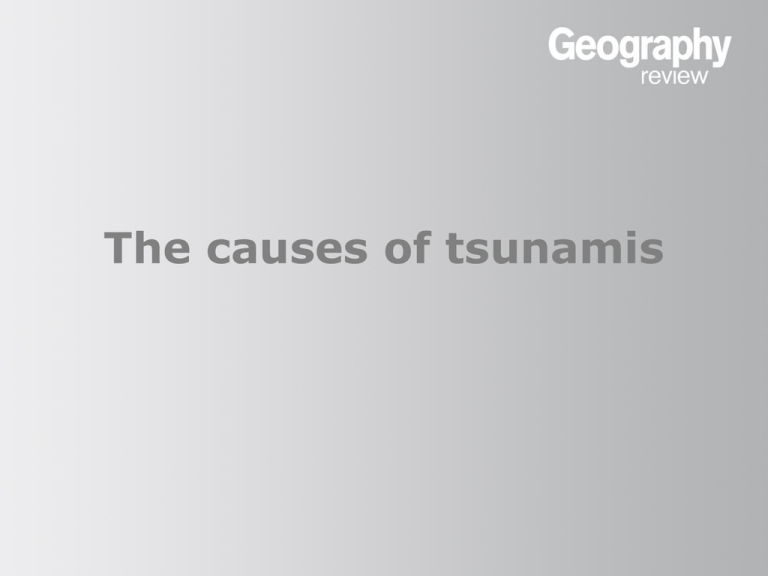Tsunami - Geoblast
advertisement

The causes of tsunamis The causes of tsunamis Tsunami •Tsunamis are secondary hazards caused number by a number of primary Example hazards such as landslides, earthquakes and even asteroid strikes. •The most common cause of major Max. wave height Krakatoa eruption, 1883 35 m Okushiri, Japan, 1993 11 m Indian Ocean, 2004 15 m translates as ‘harbour wave’ Samoa, 2009 14 m •Tsunami are sometimes called tidal Sendai, Japan, 2011 38 m tsunamis are sub-marine earthquakes (earthquakes under the sea-bed) •The word ‘tsunami’ is Japanese, and waves, but in fact have nothing to do with tides. The causes of tsunamis Tsunami triggers • Tsunamis occur when a force displaces a large volume of water • If you throw a stone in a pond, you create a mini version of concentric tsunami waves Earthquake Volcanic collapse Landslide Asteroid strike The causes of tsunamis Tsunamigenic earthquakes •Not all earthquakes that occur under the sea or ocean generate tsunamis •Those that do are called ‘tsunamigenic’ meaning tsunami-causing •To generate a tsunami, the earthquake has to cause a vertical displacement of the sea bed (see animation) •This in turn displaces water upward, which generates a tsunami at the ocean surface •Horizontal displacements of the sea bed (strike-slip faults) do not generate tsunami The causes of tsunamis Tsunami waves in open oceans • In deep ocean water, tsunami waves cannot be seen with the naked eye • This is because the wave heights are under 1 m, and often only a few tens of centimetres • Tsunami waves have wave lengths of 200 km crest to crest • Tsunami waves travel at speeds of up to 800 km an hour • As the animation shows, a tsunami originating in Hawaii takes 10-11 hours to reach Australia Tsunami travel time. Each segment = 1 hour The causes of tsunamis Shoaling waters •Only at the coast do tsunamis reveal their true character. •This is because ocean’s shallow as the coast is neared – this is called shoaling. •As water depth decreases, friction between the tsunami wave and the sea bed slows the wave down. •As the wave slows, wavelength dramatically decreases but wave height dramatically increases. •This change produces a series of huge waves metres high: The causes of tsunamis More a flood than a wave • When tsunamis hit land the effect is much more like a flood than a wave • The volume of water, and long wavelength, mean that water is pushed onshore continually and does not drain away like the backwash of a normal wave • The dramatic footage of the 2011 Sendai tsunami shows this very clearly (click on the link) • Most tsunamis are not just one wave, but several over a period of many minutes – this is sometimes called a tsunami wavetrain One of several videos posted on YouTube by Russia Today, showing the 2011 Japanese tsunami coming ashore: The causes of tsunamis Run-up height •Very large tsunami events such as the 2011 Japanese tsunami or the 2004 Indian Ocean tsunami can have run-up heights of 30 m or more • This means a high-water level 30 m above average sea level •If land at the coast is relatively flat, a tsunami can penetrate hundreds of metres inland. •In the case of the 2011 Japanese tsunami, some waves reached nearly 10 km inland from the coast





